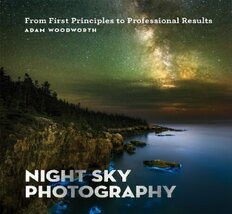
NIGHT SKY PHOTOGRAPHY : from first principles to professional results. PDF
Preview NIGHT SKY PHOTOGRAPHY : from first principles to professional results.
CONTENTS Introduction 1 OVERVIEW OF TECHNIQUES 1.1 Techniques for Low Light 1.2 Exposure Blending 2 NIGHT SKY SUBJECTS 2.1 The Milky Way 2.2 Orion Constellation 2.3 Zodiacal Light 2.4 The Big Dipper 2.5 Large Magellanic Cloud 2.6 Airglow 3 GEAR 3.1 Cameras 3.2 Lenses 3.2.1 Focal Length 3.2.2 Aperture 3.2.3 Lens Aberrations 3.2.4 Looking for a Good Lens 3.2.5 Prime vs Zoom 3.2.6 Lens Recommendations 3.3 Tripod & Ballhead 3.4 L-Bracket 3.5 Intervalometer 3.6 Lens Heater 3.7 Memory Cards 3.8 Extra Batteries 3.9 Headlamps & Flashlights 3.10 Comfort & Outdoor Gear 3.11 Personal Safety 3.12 Calibrated Display 3.13 Software 4 BREAKING DOWN AN IMAGE 4.1 Combining Exposures 5 LIGHT & NOISE 5.1 Where Noise Comes From 5.2 Capturing Light 5.3 Single Exposures 5.4 Star Stacking 5.5 Using a Star Tracker 6 CAMERA SETTINGS 6.1 Shoot Raw 6.2 White Balance 6.3 Controlling the Image Review 6.4 Long Exposure Noise Reduction 6.5 Exposure Delay & Mirror Lock-up 6.6 Other Settings 7 EXPOSURE SETTINGS 7.1 The Basics 7.2 The Histogram 7.3 Manual Mode 7.3.1 F-Stop 7.3.2 Shutter Speed 7.3.3 ISO 8 WORKING IN THE DARK 8.1 Camera Controls 8.2 Focusing 8.3 Test Shots 9 COMPOSITION 10 LIGHTING 11 PLANNING 11.1 Astronomy Basics 11.2 Star Map Programs 11.3 Using PhotoPills for Milky Way Planning 11.4 Milky Way Calendar in Planit Pro 11.5 Weather Forecasting 11.6 Finding a Dark Sky 12 MILKY WAY PANORAMAS 12.1 Shooting Panoramas 13 AURORA PHOTOGRAPHY 13.1 Exposure Settings 13.1 Planning & Forecasting 14 EDITING 14.1 Workflow 14.2 Part 1: Raw Preparation 14.3 Part 2: Star Stacking 14.4 Part 3: Exposure Blending & Focus Stacking 14.5 Part 4: Creative Adjustments 14.5.1 Color Balance 14.5.2 Levels & Curves 14.6 More Creative Adjustments 14.6.1 Protecting The Stars 14.6.2 Star Reduction 14.6.3 Noise Reduction 15 CASE STUDIES 15.1 Galactic Cave 15.2 Glowing Coast 15.3 Milky Way Panorama 15.4 West Quoddy Head Lighthouse 16 HAPPY SHOOTING! Acknowledgments HOW TO USE THIS EBOOK Select one of the chapters from the main contents list and you will be taken straight to that chapter. Look out for linked text (which is in blue) throughout the ebook that you can select to help you navigate between related sections. You can double tap images and tables to increase their size. To return to the original view, just tap the cross in the top left-hand corner of the screen. INTRODUCTION Imagine standing on the edge of a cliff in a remote area, overlooking the ocean on a clear, moonless night. The Milky Way is so bright that it reflects in the ocean, and the way it shoots up into the sky lines up with the small cove in front of you. It’s so dark you can barely see your camera in front of you when its LCD isn’t lit up, and the crashing waves below are providing a great sonic backdrop to the experience. I have been fascinated with the night sky ever since I was a kid, and I never get tired of scenes like this. Whether you’re on the coast, in the desert, or in the mountains, viewing the night sky in a dark location is always incredible. I remember seeing the Milky Way for the first time while lying down in a canoe on a lake in Maine, angling for catfish. In that moment, and ever since then, I was amazed by what it was possible to see in the night sky in the right location. So it’s fitting that I find myself, as an adult, regularly out in the middle of the night, in the middle of nowhere, taking pictures of the night sky over wilderness, lighthouses, or whatever looks promising. This type of photography is known as landscape astrophotography, and with modern digital cameras and lenses it is much easier to capture these images than ever before. Even an entry-level DSLR or a mirrorless interchangeable-lens camera with a kit lens will capture great images of the night sky. It does take some practice, and standing around in the dark while your camera takes long-exposure images requires patience, but the results will make you glad you stayed up all night. Landscape astrophotography is one of the most rewarding types of photography that I’ve personally experienced. I still get excited when I see the Milky Way pop out on the image review on the LCD of my camera. This book focuses on capturing “pinpoint stars” — where the stars appear as small, sharp points of light in the sky. The aim of this book is to show you how to achieve this while minimizing the level of noise (digital artifacts) in your images and simultaneously getting your entire scene well exposed and in focus. These are the main challenges to overcome in this type of landscape astrophotography and we’ll look at different techniques for capturing dramatic, high-quality images of the night sky. We won’t touch on star trails or moon photography, although we will briefly cover photographing the aurora and how this differs from capturing just the stars. A much longer book would be needed to cover every aspect of landscape astrophotography. At the end of this book you should be able to head out into the night with your camera gear and capture the exposures needed to create photographs that are in focus from the foreground to the stars, with little noise. You will also learn how to plan photos ahead of time and how to scout locations during the day in order to make it easier to find your composition in the dark.
